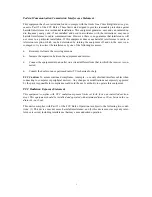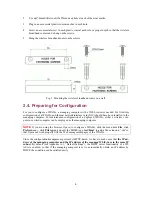
1. Introduction
1.1. Overview
The wireless broadband (switch) router enables IEEE 802.11b and Ethernet client computers to share
an Internet connection provided by an Internet service provider (ISP). The Internet connection can be
DSL, cable, V.90, or ISDN-based. In addition, it also serves as a wireless access point, so that the
wireless client computers and the Ethernet client computers can reach one another.
There are 4 different model variations,
Standard
,
Pro
,
Advanced
, and
Advanced
+, which are classified
in terms of features. The
Standard
edition provides the fewest features while the
Advanced
+ edition
provides the most. With the sleek Web-based user interface and Windows-based user interface (Wire-
less Network Manager), a network administrator can easily and clearly manage the wireless broad-
band (switch) router.
Since the wireless broadband (switch) router provides rich TCP/IP and WLAN (Wireless Local Area
Network) functionality, a basic understanding of the inner workings of TCP/IP and IEEE 802.11b is
necessary. Essential TCP/IP concepts include IP addressing, IP routing, IP name resolution, DHCP
(Dynamic Host Configuration Protocol), and PPP (Point-to-Point Protocol). Essential IEEE 802.11b
concepts include channel numbers and WEP (Wired Equivalent Privacy).
In Chapter 2, we describe the steps to install and configure a newly acquired wireless broadband
(switch) router. Following the steps, the wireless broadband (switch) router can be quickly set up to
work. In Chapter 3, detailed explanations of each Web management page are given for the user to
understand how to fine-tune the settings of a wireless broadband router to meet his or her specific
needs. In the remainder of this guide, a wireless broadband (switch) router is often referred to as a
WIASA (
Wireless Internet Access Server Appliance
) for short.
1.2. Features
Configuration Reset.
Resetting the configuration settings to factory-set values.
IEEE 802.11b
Access point.
Bridging
packets between the wireless IEEE 802.11b network interface
and the wired Ethernet LAN interface.
64-bit and 128-bit WEP (Wired Equivalent Privacy).
For authentication and data
encryption.
Enabling/disabling SSID broadcasts.
The administrator can enable or disable the
SSID broadcasts functionality for security reasons. When the SSID broadcasts functional-
ity is disabled, a client computer cannot connect to the wireless router with an “any” net-
work name (SSID, Service Set ID); the correct SSID has to be specified on client com-
puters.
MAC-address-based access control.
Blocking unauthorized wireless client com-
puters based on MAC (Media Access Control) addresses.
IEEE 802.1x/RADIUS.
User authentication and dynamic encryption key distribution can
be achieved by IEEE 802.1x Port-Based Network Access Control and RADIUS (Remote
Authentication Dial-In User Service).
1







































